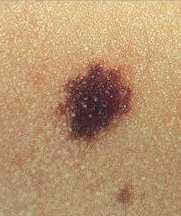Mole removal is often done for
- Cosmetic reasons
- Medical reason when a mole looks suspicious. A suspicious mole is removed and checked to see if it is a cancerous mole (melanoma) or a precancerous mole(dysplastic mole)
- Cultural reasons (fengshiu)
There are many different types of moles
Common moles
Common mole appears during childhood and adolescence. Moles become larger or darker during teenage years, during sun exposure or during pregnancy. Common moles are symmetrical and have a uniform colour. They are harmless and do not require removal. They can be removed by
- Excision surgery
- Laser surgery

Congenital moles
Congenital moles are moles that appear at birth and are considered as a birthmark. They are usually seen on the body and the majority are small and harmless. However, a large congenital mole (>20cm) has a higher risk of melanoma (up to 10%). See Dr Joyce Lim, a dermatologist if you have a congenital mole and are unsure if you need to remove it. Congenital moles are best removed by surgery as the mole can be sent for histology to determine if it is a cancerous mole

Halo naevus
Halo naevus is a common mole with a halo or white ring around it. The brown part of the mole had lost its colour. Halo neavus is benign and no treatment is needed. However, some skin cancers might mimic a halo naevus. If you are unsure whether it is indeed a halo naevus, get a consultation with Dr Joyce Lim

Dysplastic or Atypical mole
Atypical mole, also called dysplastic mole, differs from common mole by having one or more of the following:
- Asymmetry
- Irregular border
- Has more than one colour
- Larger than 6mm in diameter
Dysplastic mole is removed by surgery and the mole sent for histology

Cancerous mole(melanoma)
Most moles are benign. Suspect a cancerous mole if the mole has undergone the following changes or if you notice a new mole with the following changes
- Asymmetry between the two halves
- Borders are jagged and not smooth
- Colour change from brown to red or purple or multicolour or uneven shades of brown
- Diameter of 6mm or more or a sudden increase in size
- Evolution where there is continuous change in appearance over time
Cancerous mole must be removed and sent for histology. Melanoma is curable if detected early, having a 5-year survival rate of up to 99%.
Factors contributing to melanoma
- Repeated sun exposure with sunburn
- Repeated exposure to tanning beds
- High number of moles or unusual moles
- Family history of melanoma
If you or your family have a history of melanoma, schedule a regular skin check with Dr Joyce Lim, a dermatologist, to detect early changes in your moles and to detect any new skin cancers



